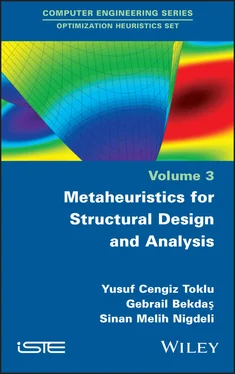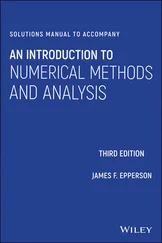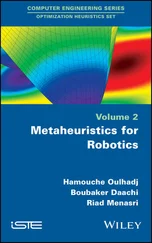Yusuf Cengiz Toklu - Metaheuristics for Structural Design and Analysis
Здесь есть возможность читать онлайн «Yusuf Cengiz Toklu - Metaheuristics for Structural Design and Analysis» — ознакомительный отрывок электронной книги совершенно бесплатно, а после прочтения отрывка купить полную версию. В некоторых случаях можно слушать аудио, скачать через торрент в формате fb2 и присутствует краткое содержание. Жанр: unrecognised, на английском языке. Описание произведения, (предисловие) а так же отзывы посетителей доступны на портале библиотеки ЛибКат.
- Название:Metaheuristics for Structural Design and Analysis
- Автор:
- Жанр:
- Год:неизвестен
- ISBN:нет данных
- Рейтинг книги:4 / 5. Голосов: 1
-
Избранное:Добавить в избранное
- Отзывы:
-
Ваша оценка:
- 80
- 1
- 2
- 3
- 4
- 5
Metaheuristics for Structural Design and Analysis: краткое содержание, описание и аннотация
Предлагаем к чтению аннотацию, описание, краткое содержание или предисловие (зависит от того, что написал сам автор книги «Metaheuristics for Structural Design and Analysis»). Если вы не нашли необходимую информацию о книге — напишите в комментариях, мы постараемся отыскать её.
Metaheuristics for Structural Design and Analysis — читать онлайн ознакомительный отрывок
Ниже представлен текст книги, разбитый по страницам. Система сохранения места последней прочитанной страницы, позволяет с удобством читать онлайн бесплатно книгу «Metaheuristics for Structural Design and Analysis», без необходимости каждый раз заново искать на чём Вы остановились. Поставьте закладку, и сможете в любой момент перейти на страницу, на которой закончили чтение.
Интервал:
Закладка:
There have been very elegant techniques using classical tools of mathematics for solving this optimization problem, in cases where functions in F(x)are well defined and differentiable. Unfortunately, all of these methods are valid only in their range of applicability, as in linear programming, nonlinear programming, integer programming, gradient methods, etc. (Nocedal and Wright 2006; Fletcher 2013). In real life, most of the objective functions are such that they cannot be written down as a mathematical function, let alone a differentiable one. On the other hand, the unknowns may be any type of quantity, floating or integer numbers, names, directional expressions, the order of some activities, etc. Therefore, we can surely conclude that mathematical optimization methods cannot handle these problems, which form the great majority of problems encountered in real life.
Metaheuristic methods, fortunately, are capable of handling all of these problems. Properly designed, they can help in making decisions on the best topology of a structural element, an economic activity with maximum income, the best hourly schedule in a school, the best route to follow between two points, etc. The term “metaheuristic” was first coined for the tabu search method, viewing it as “a metaheuristic superimposed on another heuristic” (Glover 1986). Humans started to use these techniques consciously in the 20th century, although nature was probably using them from the very beginning. For instance, evolutionary theory shows that living organisms of today started from single-celled beings, following the optimization rule of best fit, under an unimaginable number and variety of constraints. A genetic algorithm, a popular metaheuristic algorithm, is just an imitation of this process. Currently, there are hundreds of metaheuristic algorithms, as well as hybrid ones, that are applied to a wide variety of optimization problems in science, engineering, economics, arts, etc.
Metaheuristic algorithms are also considered to be one of the most useful tools of artificial intelligence, taking into account that self-learning and rule-of-thumb decisions are their two basic properties.
This book is intended to give a review of metaheuristic algorithms and their applications in a very specific field: structural design and analysis. It is to be noted that this is the first book to deal with the application of metaheuristic algorithms to structural analysis.
I.2. Structure of the book
This book is organized in the following manner.
Chapter 1gives a short history of structural analysis and design, from the times when these activities were performed using intuition and experience, without making any calculations, to times when tools used in artificial intelligence became frequent applications. This chapter emphasizes that the finite element method (FEM) plays a special role, whilst also noting that every step in this long voyage had a certain importance.
Chapter 2gives an overview of metaheuristic algorithms (MAs). These algorithms started to be consciously used in the second half of the 20th century, enabling optimization problems to be solved that were untouchable before that time. In the beginning, there were only a handful of MAs, now the number certainly runs into the hundreds. In this chapter, some general properties of all of these algorithms are discussed, and about ten are investigated in detail.
Metaheuristic algorithms are successfully applied to structural problems. A general overview of these applications is given in Chapter 3, with emphasis on various aspects of the aims of optimization, i.e. the objectives. Examples are given in terms of weight, cost, effectiveness optimization, minimization of CO 2emissions and dealing with limitations of stresses, deformations, stability, fatigue and national and international specifications.
The following four chapters are dedicated to design optimization. Generalities about applications of metaheuristic algorithms on structural design are discussed in Chapter 4. Chapter 5deals with trusses and truss-like structures, Chapter 6focuses on optimization of structural elements, and optimization of structural control members is the subject of Chapter 7. In all three of these chapters, after providing basic information about the subject, relevant numerical examples are given. Thus, in this part, the reader can find solutions for the optimization of an I-beam, a tubular column, a cantilever beam, trusses with elements – in which the number changes between 5 and 200 – reinforced concrete members, frames, walls and tuned mass dampers.
As stated in Chapter 3, optimization procedures can be useful not only in structural design but also in structural analysis. This subject is addressed in Chapter 8. The idea of these applications is the direct use of the minimum potential energy principle of mechanics in determining the equilibrium position of a structure. It is explained in the chapter that a method, named Total Potential Optimization using Metaheuristic Algorithms (TPO/MAs), was launched for this purpose, which can also be looked upon as Finite Element Method with Energy Minimization (FEMEM). In the chapter, the fundamentals of the method are given, together with applications on trusses, truss-like structures and plates.
Applications of metaheuristic algorithms on the design and analysis of structures are a relatively new subject with advances made every year and in every corner of the globe. In the concluding chapter, future expectations on this subject are discussed. It is stated that the tools used nowadays are basic tools of Artificial Intelligence (AI) and that with the amalgamation of design and analysis – along with other aspects of construction like management, planning, financing, controlling and site work – a huge problem lies ahead, requiring much more elaborate tools in order to be solved. When one considers that these operations will not only be carried out in familiar environments, but also perhaps in remote areas with harsh conditions, the difficulty of the task awaiting humanity can somehow be envisaged.
1
Evolution of Structural Analysis and Design
Design and analysis are two extremely important aspects of structural engineering. Although they are known to be applied side by side, or one inside the other, historically, the case was different. Design began in the very early ages, together with the first human settlements, while analysis only saw the light of day during the Age of Enlightenment. In early times, the design of structures was accomplished by intuition, observation, experimentation and experience, as can be seen in the applications of ziggurats, pyramids, St. Sophia in Istanbul, Notre Dame in Paris and other historical structures of varying sizes.
Structural analysis involves concepts such as forces, bending moments, torques, stresses, strains, deformations, deflections, rotations and warping, which are difficult to comprehend for those who are not educated in this specific subject. Also, it is evident that comprehension of these concepts is not sufficient to produce any type of analysis; it has to be enriched by knowledge in order to conceive a mathematical model, after making some meaningful assumptions, as well as computational experience to solve multiple equations or to find the minimum of a function. Hence, analysis, which we know today to be part of design, was developed much later than the design that was sufficient to build many important structures like the ones cited above. Of course, now humans can design structures that were previously in conceivable as a result of our improved powers of analysis, amongst other factors.
1.1. History of design
Designing a structure requires that certain questions be answered in relation to safety, functionality, economy, sustainability, aesthetics and comfort. The first question, that of safety, is directly related to structural analysis. It involves characterizing the materials to be used in the structure, making a mathematical model of the structure after making some meaningful assumptions, giving meaningful dimensions to the elements of the structure, determining design forces with a distinction between dead and live forces and calculating internal effects in the structures under different loadings, so as to support reactions, stresses, strains, deflections and rotations. Then comes the stage for determining the safety of the structure, i.e. deciding whether the structure, whose behavior has been calculated, is sufficiently strong to resist the acting forces with a meaningful factor of safety, whether the stresses are less than the materials can safely carry and whether the deflections and rotations are not severe enough to create a sense of discomfort. If any of the answers to these questions are negative, then either the dimensions of the structure will be changed or, in some cases, the entire model will be changed as a more radical measure. A change in the dimensions may be in two directions: increase the dimensions if the element is overstressed, or decrease them if the element is highly under-stressed to avoid having a structure that is far from economical.
Читать дальшеИнтервал:
Закладка:
Похожие книги на «Metaheuristics for Structural Design and Analysis»
Представляем Вашему вниманию похожие книги на «Metaheuristics for Structural Design and Analysis» списком для выбора. Мы отобрали схожую по названию и смыслу литературу в надежде предоставить читателям больше вариантов отыскать новые, интересные, ещё непрочитанные произведения.
Обсуждение, отзывы о книге «Metaheuristics for Structural Design and Analysis» и просто собственные мнения читателей. Оставьте ваши комментарии, напишите, что Вы думаете о произведении, его смысле или главных героях. Укажите что конкретно понравилось, а что нет, и почему Вы так считаете.












